Verdict
The Nord 2T doesn’t bring a groundbreaking update on the original Nord 2, but it’s one of the best affordable mid-range Android handsets around. Its main camera is great, the design is better than most at the price, and the MediaTek processor within is remarkably powerful. Limited display brightness in direct sunlight is likely the main potentially off-putting area of concern.
Pros
- Classy glass design with refined haptics
- Excellent gaming and general performance for the money
- Strong primary camera, good low-light performance
Cons
- Quite similar to the Nord 2
- Speakers lack low-end weight
- Disappointing display brightness in direct sunlight
Availability
- UKRRP: £369
- USAunavailable
- Canadaunavailable
- Australiaunavailable
-
MediaTek Dimensity 1300 SoCLess popular than a Qualcomm chip, the Dimensity SoC here delivers gaming performance comparable with a last-generation Qualcomm Snapdragon processor. -
Sony IMX766 50-megapixel cameraFeaturing the same Sony IMX766 camera sensor as the Nord 2, this is one of the best units you’ll find at the price. -
Glass rear panelA glass back makes the OnePlus Nord 2T feel a little more expensive than handsets of a similar price. The good haptics and the use of metal side buttons also partially mask the plastic sides
Introduction
Are you looking for some of the original spirit of OnePlus: the flagship experience at an affordable price? Then the Nord series is arguably a better place to start than the mainline OnePlus handsets.
The OnePlus Nord 2T is a mid-range Android that costs £369 (it’s not currently available in the US), delivering many of the characteristics I look for in top-tier Androids. These include features such as a quality camera that takes decent low-light photos, fast general performance and a solid ability to handle games, plus a construction that isn’t entirely plastic; screen display glass doesn’t count.
OnePlus has come out as a sibling of Realme and Oppo, but the OnePlus Nord 2T represents a better deal than almost anything from those brands for most buyers.
Design and Screen
- Classic tasteful OnePlus colour options
- Higher-end feel as a result of refined haptics and a glass back
- Decent in-screen fingerprint reader
OnePlus offers phones in more tasteful colour options than most of the competition, and the Nord 2T is a good example. Mid-range phones such as this often go all-out on bold gradients and shiny effects. If that’s your bag, great. However, don’t you think the light mint green here offers a little more sophistication?
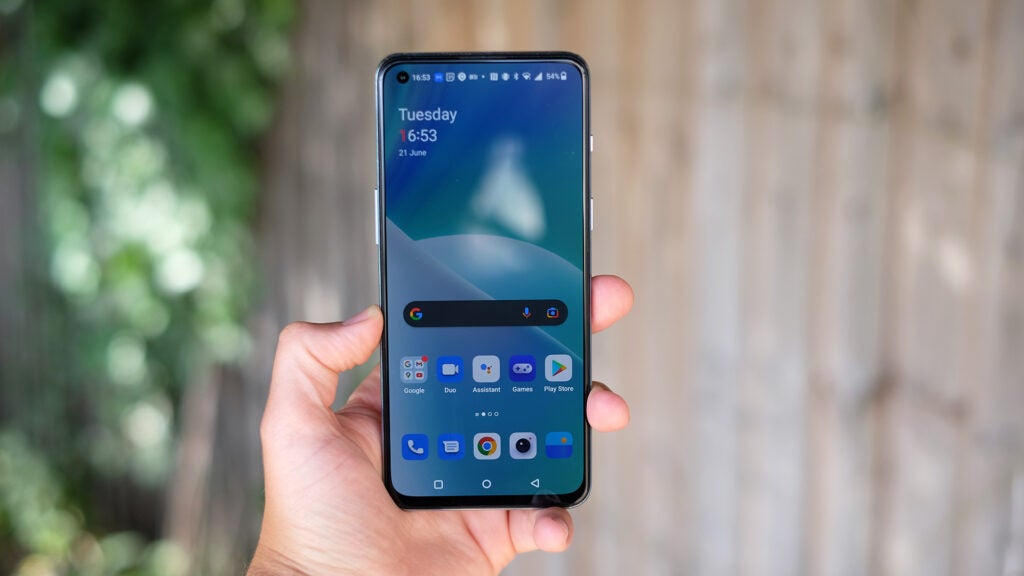
The OnePlus Nord 2T is an unusually classy-looking phone, whose design is only dimmed by the camera housing. Its dual circle motif is fine, but the off-centre positioning of the two secondary cameras is a bit clunky.
They sit there for a reason, of course; but if this were a higher-end phone, you’d expect a little more effort and expense to be put into making these finer points appear just right.
The rest of the design is top-tier stuff. We get a lovely curved glass back, and while the metallic-looking sides are plastic, expecting a full metal and glass design with the Nord 2T’s specs at this price just isn’t realistic.
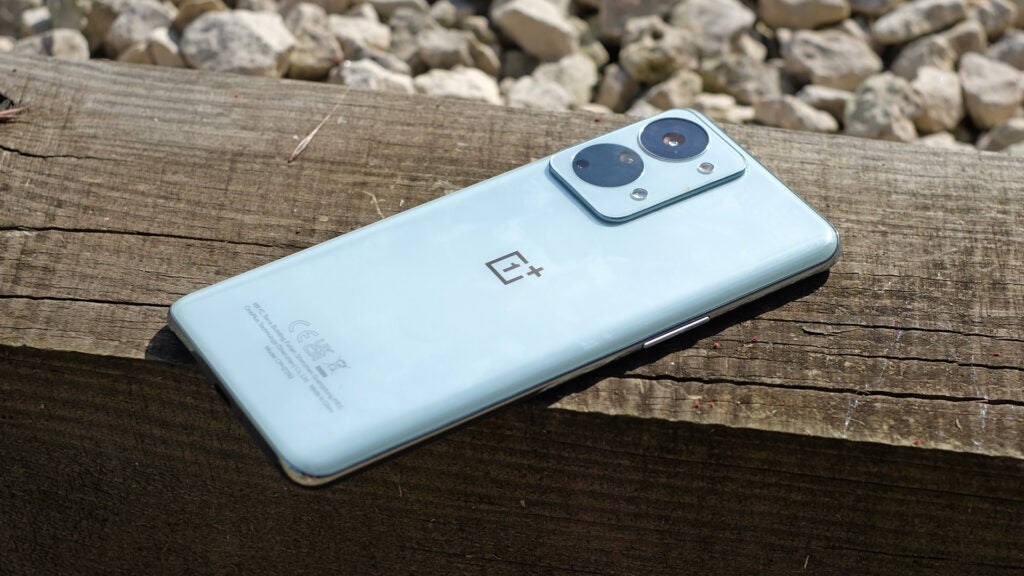
This is a smaller phone than many mid-range models, as a result of its 6.43-inch display. While its size isn’t ideal for gaming, it certainly makes the OnePlus Nord 2T easier to handle. It’s a more approachable handset for the kind of person who would pick an iPhone 13 Pro over an iPhone 13 Pro Max – and not only for its lower cost.
There’s no headphone jack, nor microSD memory card slot, but there are a couple of other neat hardware features. Like other OnePlus phones, the Nord 2T has a silent mode slider that lets you switch between vibrate-only and a true silent mode with the swipe of a thumb. The fingerprint scanner also uses an in-screen sensor, whereas phones at this price typically have side-mounted units.
This scanner is a little slower than the pad of the top OnePlus phones, but it does help elevate the Nord 2T, making it appear a higher class of affordable Android.
The phone comes with stereo speakers, and they’re loud. They can blast over the sound of cooking, or a shower. However, they don’t have the low-end power that helps smooth out the audio of louder phone speakers. They lack the weight of the best and can sound a bit abrasive at high volumes.
The OnePlus Nord 2T’s 6.43-inch screen is where we see some restraint, which has probably helped OnePlus to include neat touches such as the in-screen finger scanner. This is an OLED Full HD display, but it has a 90Hz refresh rate rather than the 120Hz kind seen in some rivals.
This isn’t necessarily a big deal. The slight jerkiness while scrolling at 60Hz becomes more obvious when you’ve become accustomed to 120Hz high refresh rate displays; but 90Hz still looks smooth. It may be half-way between the two, but returns start to diminish (without disappearing altogether) after 90Hz.
There are two colour modes and, as is the case with the handset’s design, these are more restrained than those of alternatives from OnePlus sister company Realme. The default Vivid appears to be a DCI-P3 preset, while natural is modelled after sRGB, and will look far too weak for many folk these days.
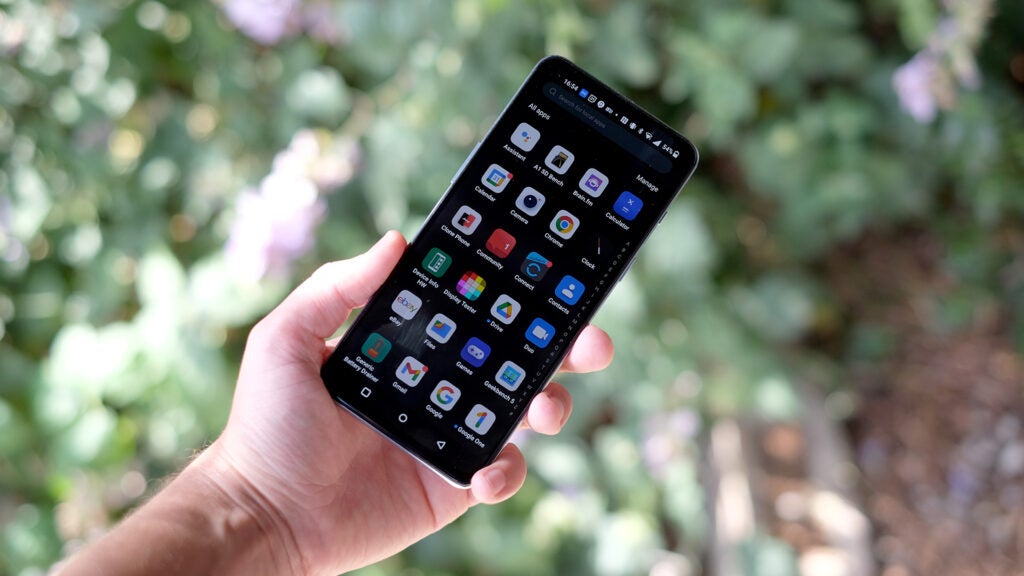
It’s great to have the option, but I find that – in a reversal of the normal situation – it makes photos taken with the camera appear a little undersaturated. This is likely because the camera takes shots in the RGB colour space, but the sRGB colour mode is so strict that it won’t display the full range of colours in those images. As ever, baked-in camera gallery apps should be able to apply their own calibration settings.
OnePlus often makes big claims about the brightness of its phones’ screens. There are none attached to the OnePlus Nord 2T; it reaches 460 nits indoors, which is fine. Brightness outdoors is a little below average at 630 nits. If you want a phone that offers great outdoor visibility, the Realme GT Neo 2T is a better option – its display measured in at 770 nits for brightness.
Software and Performance
- Great gaming performance
- OxygenOS is fine, apart form the irritating Shelf feature
- Performance comparable
OnePlus was once celebrated for the software offering that accompanied its Android phones. Its UI is called OxygenOS, and at one point was planned to be replaced by Oppo’s ColorOS – until there was an outcry from the OnePlus fanbase.
There are a few annoying elements in the latest version of the software. Flick down from the right of the homescreen and Shelf pops up. This is a bit like the menu that pops up with a similar gesture on iPhones. But where Apple’s is useful, Shelf kind of isn’t.
It’s home to widgets, like the weather; one that shows how much storage the phone has left; and a Spotify panel. You’re far more likely to bring it up accidentally, when you mean to pull down your notifications.
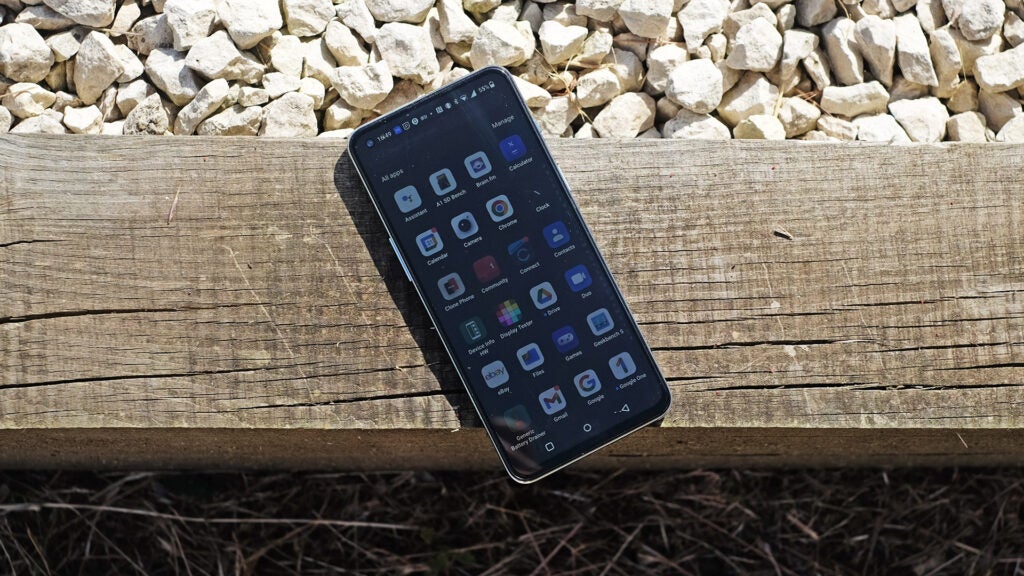
Thankfully, you can turn it off, and I strongly recommend you do so. The OnePlus Nord 2T interface becomes much more vanilla having done so, with no more upsetting surprises in store.
There’s a neat Always-On display mode of which I’m a fan. It shows icons for recent notifications, displays the time, and offers a guide as to where the fingerprint scanner sits. Useful.
The Always-On display can be customised, and – if you’d rather save battery – switched off entirely. We’ve probably seen the best days of OxygenOS at this point, but it’s still easy to get on with once you banish the irritating Shelf.
There is no third-party bloatware to be found here, just a few utility apps and Zen mode, an almost comically hardcore meditation-adjacent app. Set the timer and it blocks off notifications, alongside access to all of your apps bar the camera. Calls will still come, through – OnePlus doesn’t want to be at the centre of news stories about anyone missing the birth of their child because of Zen mode. Nice idea, though.
At the heart of the OnePlus Nord 2T sits the new version of the MediaTek Dimensity 1200 seen in the Nord 2. The Dimensity 1300 is a little faster in both GPU and CPU areas.
This is a great processor for a phone at the price, in particular representing a real jump in GPU performance over most sub-£400 phones. The one chipset I might pick over it is the Qualcomm Snapdragon 870, which is a fantastic mid-range SoC. But I imagine this might be more expensive, and the OnePlus Nord 2T is nothing if not a cost-sensitive phone.
It scores 2732 in Geekbench 5, 738 per core. This is similar to the Realme GT 3T Neo’s score with a Snapdragon 870. In 3DMark’s Wild Life test it scores 4637 points, roughly 10% higher than a Snapdragon 870 phone.
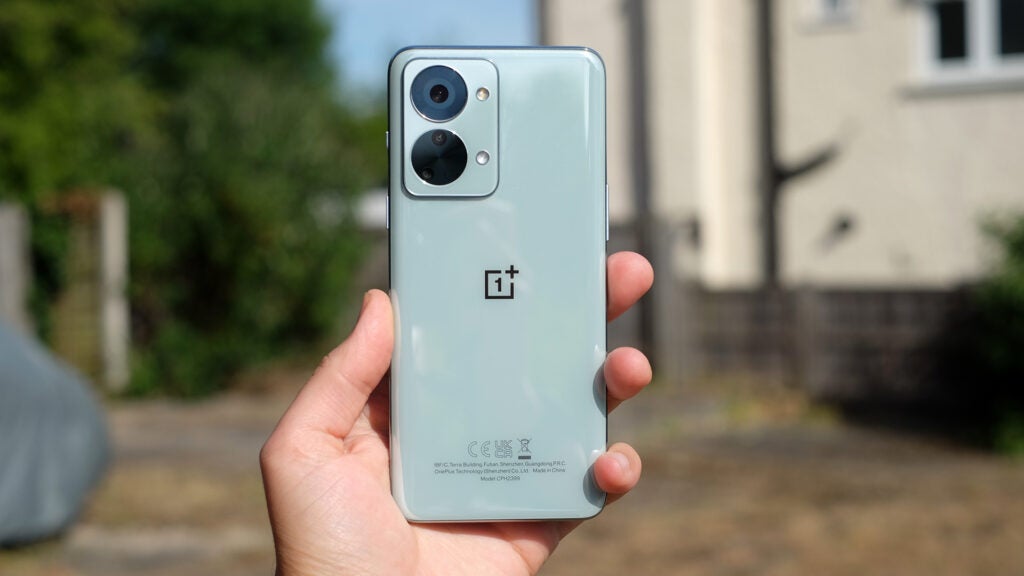
Performance stability over a 20-minute stress test is fantastic at 99.3%, meaning there’s no thermal throttling when running a challenging 3D game that’s within the phone’s capabilities.
The OnePlus Nord 2T’s handles Fortnite beautifully. All the graphics options are unlocked, including the Epic fidelity preset and 60fps play at High graphics. Frequently this isn’t the case at this level.
Both of these top-end ways to play are within the Nord 2T’s comfort zone. While there are slight frame rate dips from the caps on occasion, such as when falling from the drop shop at the start of a round, you see these even in Snapdragon 8 Gen 1 phones.
If you see a game performing less well than you’d hoped, check for software updates.
Camera
- Great image quality from primary camera
- 4K/30 video offers limited stabilisation
- Limited-quality ultra-wide, pointless monochrome sensor
The OnePlus Nord 2T has the same primary camera hardware as the Nord 2: a Sony IMX766 sensor with an f/1.88 lens. This is a large sensor and just about the best you’ll find for the money. It also makes an appearance in the £600 Realme GT 3 Neo and the £1000-plus Oppo Find X5 Pro.
However, software handling matters just as much as hardware these days, so how does the OnePlus Nord 2T compare? Pretty well.
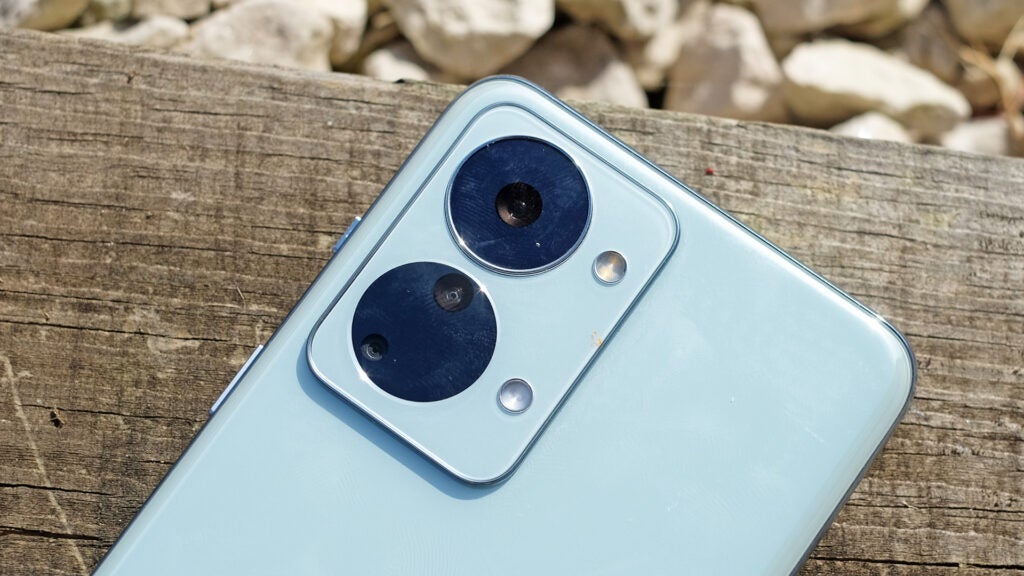
Photos taken with the primary camera deliver natural-looking colour and good dynamic range. Thanks to the high-quality sensor and dedicated Night mode, image quality holds up remarkably well in challenging lighting.
Lower-cost phones are starting to use proper computational night modes, but only good camera hardware is going to get you solid photos of your homemade burgers shot in a living room lit only by a shaded 60W bulb or two. The OnePlus Nord 2T performs impressively in both scenarios, night and dingy lighting, comparable with some phones twice the price.
The OnePlus Nord 2 had one of the best affordable mid-range phone cameras you’ll find. And while this new model doesn’t bring a mind-blowing improvement, it still outpaces most at the price. You’ll have to wait for the Pixel 6a to get something that’s potentially better.
There are just a few minor issues. I’ve found that detail dips a tad when you use the dedicated Night mode, and that results can vary a little between exposures, most likely caused by hand-shake during capture. However, this shouldn’t really be an issue when the OnePlus Nord 2T has optical image stabilisation.
The 50-megapixel mode also brings virtually zero improvement to fine detail at pixel level. Shots barely look any different to the standard 12.5-megapixel images blown up in size on Photoshop; 2x digital zoom images are only okay, too. They do at least use a processing style more tuned than the 50-megapixel mode, in order to offer a better impression of sharp, fine detail; but they don’t hold up that well close-up.









The OnePlus Nord 2T is also fractionally slower to shoot than some of the other phones I’ve used recently, such as the Realme GT 3 Neo and Poco F4 GT. However, this isn’t a major issue when you consider the phone’s £369 price. Camera quality is one of the better reasons to pick a Nord 2T over some of the alternatives.
I’ve hardly mentioned the secondary cameras yet. The 8-megapixel ultra-wide comes with the usual mid-range compromises. Pictures don’t hold up that well when you zoom in, but can look better than many I’ve tried at this level recently. Image character is fairly consistent with the primary camera, and the lens handles strong light sources remarkably well.
The third camera is a 2-megapixel monochrome unit, and it’s likely to go unused by many OnePlus Nord 2T owners. It only appears to be employed in a B&W filter mode or two found deep in the camera app, as an aid for the main camera. Totally pointless.
Video also comes with a few compromises. You can shoot at 4K resolution, but only at 30 frames per second. The detail and clarity of day-lit 4K is excellent, but stabilisation is limited. It appears to rely on not-that-impressive OIS and, possibly, a tiny bit of software stabilisation. The 4K field of view is slightly narrower than that of standard 1x photos, suggesting some EIS may be present.
However, this isn’t enough to make hand-held walking footage look smooth, the image lurching when you overpower the OIS with too much motion.
There are two other key options. You can shoot standard 1080p, with enhanced software stabilisation but a softer image. Or turn on the Ultra Steady mode – this doesn’t use the ultra-wide camera, instead just cropping even further into the frame to fuel the software stabilisation. This is smart, maxing out on the use of the best sensor on the phone.
The OnePlus Nord 2T also has an AI mode designed primarily for low-light video. It’s limited to 1080p/30fps and supports “Live HDR”, which is likely an implementation of DOL-HDR – a sensor-level feature, where two different exposures can be captured per frame simultaneously.
However, it’s best used for scenes where you won’t move the camera much, since motion is significantly worse than when shooting at normal 1080p/30fps. Still, low-light video quality is already above average at the price thanks to the large high-quality sensor.
The front camera is a Sony IMX615, a 32-megapixel sensor. It’s a great front camera for a phone this affordable, and while it actually spits out 32-megapixel images, it likely makes use of pixel binning to improve image quality in low light.
Battery Life
- Okay battery life at standard settings, good stamina at 60Hz
- 80W fast-charging is speedy, but not a significant upgrade over 65W
- No wireless charging
The OnePlus Nord 2T isn’t a huge phone and, no surprise, doesn’t come with a huge battery. It’s a 4500mAh unit, just like the Nord 2’s.
For the first week or so of testing, I used the phone in its default modes. It was set to the 90Hz refresh rate, with the Always-On display mode turned on.
With this setup, you’ll see stamina that’s similar to the last-generation Nord, and pretty alike higher-end OnePlus phones. This handset isn’t made to take a battering, with long stints spent streaming YouTube or playing 3D games. I typically ended up with at most 15% battery left by the end of the day.
It isn’t a worryingly short-lasting battery, neither is it a trooper. However, I attempted to tone down some settings, without doing anything that would limit system performance, to see whether it would make a difference.
After switching off Always-On mode and dropping the display refresh rate to 60Hz, the phone had 44% charge remaining by bed time. This was a slightly lighter day of use, but it does show that there are steps you can take to improve battery performance on those occasions you won’t be able to give the OnePlus Nord 2T a top-up.
Charging gets a boost over the OnePlus Nord 2 – on paper, at least. The Nord 2T offers 80W charging, up from 65W in the Nord 2. However, according to our power meter, it maxed out at 70W draw and had already dropped down to 45-46W by minute two of charging. The peak rates are partly for show.
It reached 50% in 17 minutes, and took 48 minutes to charge the device to full, having reached “100%” on its display almost 10 minutes earlier at the 39-minute mark. Charging speeds will be affected by ambient temperatures, but this isn’t quite as quick as you might have hoped for from an “80W” charging system.
Note that there’s no support for wireless charging, as in the Nord 2.
Latest deals
Should you buy it?
The OnePlus Nord 2T is a star, if you want a top value mid-range phone whose design is more sophisticated than most. It’s further enhanced by refined haptics, the SoC is excellent, and the primary camera is a top performer in virtually all conditions. There’s more than a hint of that old OnePlus magic on display here.
Own a Nord 2? There’s very little reason to upgrade then. While some improvements have been made throughout, and a newer SoC included, the difference isn’t dramatic –and the Nord 2 holds up well anyway in 2022.
Final Thoughts
The OnePlus Nord 2T isn’t a groundbreaking update on the Nord 2, but it’s nonetheless one of the very best affordable mid-range phones available in 2022. It offers a killer combination of style and technical ability that even value leaders such as Xiaomi and Realme struggle to match.
On the style front we get tasteful colours, a glass rear panel, elegant haptics and an in-screen fingerprint reader, usually associated with more expensive Android handsets. Hardware highlights include a MediaTek SoC that delivers great gaming performance with minimal throttling, and a top-tier Sony IMX766-based camera that holds up well in virtually any shooting scenario.
Issues? While the OnePlus Nord 2T’s stereo speakers are loud, they lack the rounded tone of a set with greater low-frequency content. And the screen doesn’t get hugely bright outdoors, limiting visibility in direct sunlight.
How we test
We test every mobile phone we review thoroughly. We use industry standard tests to compare features properly and we use the phone as our main device over the review period. We’ll always tell you what we find and we never, ever, accept money to review a product.
Used as main phone for over a week
Tested the camera in various surroundings
Mixture of benchmarks and real-world use
FAQs
The phone doesn’t come with a water- or dust-resistance rating, so keep it away from water.
There’s no 3.5mm headphone jack on the phone.
Wireless charging isn’t supported; there’s only cabled charging here.
Trusted Reviews test data
Sustainability
TrustedReviews’ holds the fact that global warming is not a myth as a core value and will continuously endeavor to help protect our planet from harm in its business practices.
As part of this mission, whenever we review a product we send the company a series of questions to help us gauge and make transparent the impact the device has on the environment.
We currently haven’t received answers to the questions on this product, but will update this page the moment we do. You can see a detailed breakdown of the questions we ask and why in our sustainability info page.
Verdict
The Nord 2T doesn’t bring a groundbreaking update on the original Nord 2, but it’s one of the best affordable mid-range Android handsets around. Its main camera is great, the design is better than most at the price, and the MediaTek processor within is remarkably powerful. Limited display brightness in direct sunlight is likely the main potentially off-putting area of concern.
Pros
- Classy glass design with refined haptics
- Excellent gaming and general performance for the money
- Strong primary camera, good low-light performance
Cons
- Quite similar to the Nord 2
- Speakers lack low-end weight
- Disappointing display brightness in direct sunlight
Availability
- UKRRP: £369
- USAunavailable
- Canadaunavailable
- Australiaunavailable
-
MediaTek Dimensity 1300 SoCLess popular than a Qualcomm chip, the Dimensity SoC here delivers gaming performance comparable with a last-generation Qualcomm Snapdragon processor. -
Sony IMX766 50-megapixel cameraFeaturing the same Sony IMX766 camera sensor as the Nord 2, this is one of the best units you’ll find at the price. -
Glass rear panelA glass back makes the OnePlus Nord 2T feel a little more expensive than handsets of a similar price. The good haptics and the use of metal side buttons also partially mask the plastic sides
Introduction
Are you looking for some of the original spirit of OnePlus: the flagship experience at an affordable price? Then the Nord series is arguably a better place to start than the mainline OnePlus handsets.
The OnePlus Nord 2T is a mid-range Android that costs £369 (it’s not currently available in the US), delivering many of the characteristics I look for in top-tier Androids. These include features such as a quality camera that takes decent low-light photos, fast general performance and a solid ability to handle games, plus a construction that isn’t entirely plastic; screen display glass doesn’t count.
OnePlus has come out as a sibling of Realme and Oppo, but the OnePlus Nord 2T represents a better deal than almost anything from those brands for most buyers.
Design and Screen
- Classic tasteful OnePlus colour options
- Higher-end feel as a result of refined haptics and a glass back
- Decent in-screen fingerprint reader
OnePlus offers phones in more tasteful colour options than most of the competition, and the Nord 2T is a good example. Mid-range phones such as this often go all-out on bold gradients and shiny effects. If that’s your bag, great. However, don’t you think the light mint green here offers a little more sophistication?

The OnePlus Nord 2T is an unusually classy-looking phone, whose design is only dimmed by the camera housing. Its dual circle motif is fine, but the off-centre positioning of the two secondary cameras is a bit clunky.
They sit there for a reason, of course; but if this were a higher-end phone, you’d expect a little more effort and expense to be put into making these finer points appear just right.
The rest of the design is top-tier stuff. We get a lovely curved glass back, and while the metallic-looking sides are plastic, expecting a full metal and glass design with the Nord 2T’s specs at this price just isn’t realistic.

This is a smaller phone than many mid-range models, as a result of its 6.43-inch display. While its size isn’t ideal for gaming, it certainly makes the OnePlus Nord 2T easier to handle. It’s a more approachable handset for the kind of person who would pick an iPhone 13 Pro over an iPhone 13 Pro Max – and not only for its lower cost.
There’s no headphone jack, nor microSD memory card slot, but there are a couple of other neat hardware features. Like other OnePlus phones, the Nord 2T has a silent mode slider that lets you switch between vibrate-only and a true silent mode with the swipe of a thumb. The fingerprint scanner also uses an in-screen sensor, whereas phones at this price typically have side-mounted units.
This scanner is a little slower than the pad of the top OnePlus phones, but it does help elevate the Nord 2T, making it appear a higher class of affordable Android.
The phone comes with stereo speakers, and they’re loud. They can blast over the sound of cooking, or a shower. However, they don’t have the low-end power that helps smooth out the audio of louder phone speakers. They lack the weight of the best and can sound a bit abrasive at high volumes.
The OnePlus Nord 2T’s 6.43-inch screen is where we see some restraint, which has probably helped OnePlus to include neat touches such as the in-screen finger scanner. This is an OLED Full HD display, but it has a 90Hz refresh rate rather than the 120Hz kind seen in some rivals.
This isn’t necessarily a big deal. The slight jerkiness while scrolling at 60Hz becomes more obvious when you’ve become accustomed to 120Hz high refresh rate displays; but 90Hz still looks smooth. It may be half-way between the two, but returns start to diminish (without disappearing altogether) after 90Hz.
There are two colour modes and, as is the case with the handset’s design, these are more restrained than those of alternatives from OnePlus sister company Realme. The default Vivid appears to be a DCI-P3 preset, while natural is modelled after sRGB, and will look far too weak for many folk these days.

It’s great to have the option, but I find that – in a reversal of the normal situation – it makes photos taken with the camera appear a little undersaturated. This is likely because the camera takes shots in the RGB colour space, but the sRGB colour mode is so strict that it won’t display the full range of colours in those images. As ever, baked-in camera gallery apps should be able to apply their own calibration settings.
OnePlus often makes big claims about the brightness of its phones’ screens. There are none attached to the OnePlus Nord 2T; it reaches 460 nits indoors, which is fine. Brightness outdoors is a little below average at 630 nits. If you want a phone that offers great outdoor visibility, the Realme GT Neo 2T is a better option – its display measured in at 770 nits for brightness.
Software and Performance
- Great gaming performance
- OxygenOS is fine, apart form the irritating Shelf feature
- Performance comparable
OnePlus was once celebrated for the software offering that accompanied its Android phones. Its UI is called OxygenOS, and at one point was planned to be replaced by Oppo’s ColorOS – until there was an outcry from the OnePlus fanbase.
There are a few annoying elements in the latest version of the software. Flick down from the right of the homescreen and Shelf pops up. This is a bit like the menu that pops up with a similar gesture on iPhones. But where Apple’s is useful, Shelf kind of isn’t.
It’s home to widgets, like the weather; one that shows how much storage the phone has left; and a Spotify panel. You’re far more likely to bring it up accidentally, when you mean to pull down your notifications.

Thankfully, you can turn it off, and I strongly recommend you do so. The OnePlus Nord 2T interface becomes much more vanilla having done so, with no more upsetting surprises in store.
There’s a neat Always-On display mode of which I’m a fan. It shows icons for recent notifications, displays the time, and offers a guide as to where the fingerprint scanner sits. Useful.
The Always-On display can be customised, and – if you’d rather save battery – switched off entirely. We’ve probably seen the best days of OxygenOS at this point, but it’s still easy to get on with once you banish the irritating Shelf.
There is no third-party bloatware to be found here, just a few utility apps and Zen mode, an almost comically hardcore meditation-adjacent app. Set the timer and it blocks off notifications, alongside access to all of your apps bar the camera. Calls will still come, through – OnePlus doesn’t want to be at the centre of news stories about anyone missing the birth of their child because of Zen mode. Nice idea, though.
At the heart of the OnePlus Nord 2T sits the new version of the MediaTek Dimensity 1200 seen in the Nord 2. The Dimensity 1300 is a little faster in both GPU and CPU areas.
This is a great processor for a phone at the price, in particular representing a real jump in GPU performance over most sub-£400 phones. The one chipset I might pick over it is the Qualcomm Snapdragon 870, which is a fantastic mid-range SoC. But I imagine this might be more expensive, and the OnePlus Nord 2T is nothing if not a cost-sensitive phone.
It scores 2732 in Geekbench 5, 738 per core. This is similar to the Realme GT 3T Neo’s score with a Snapdragon 870. In 3DMark’s Wild Life test it scores 4637 points, roughly 10% higher than a Snapdragon 870 phone.

Performance stability over a 20-minute stress test is fantastic at 99.3%, meaning there’s no thermal throttling when running a challenging 3D game that’s within the phone’s capabilities.
The OnePlus Nord 2T’s handles Fortnite beautifully. All the graphics options are unlocked, including the Epic fidelity preset and 60fps play at High graphics. Frequently this isn’t the case at this level.
Both of these top-end ways to play are within the Nord 2T’s comfort zone. While there are slight frame rate dips from the caps on occasion, such as when falling from the drop shop at the start of a round, you see these even in Snapdragon 8 Gen 1 phones.
If you see a game performing less well than you’d hoped, check for software updates.
Camera
- Great image quality from primary camera
- 4K/30 video offers limited stabilisation
- Limited-quality ultra-wide, pointless monochrome sensor
The OnePlus Nord 2T has the same primary camera hardware as the Nord 2: a Sony IMX766 sensor with an f/1.88 lens. This is a large sensor and just about the best you’ll find for the money. It also makes an appearance in the £600 Realme GT 3 Neo and the £1000-plus Oppo Find X5 Pro.
However, software handling matters just as much as hardware these days, so how does the OnePlus Nord 2T compare? Pretty well.

Photos taken with the primary camera deliver natural-looking colour and good dynamic range. Thanks to the high-quality sensor and dedicated Night mode, image quality holds up remarkably well in challenging lighting.
Lower-cost phones are starting to use proper computational night modes, but only good camera hardware is going to get you solid photos of your homemade burgers shot in a living room lit only by a shaded 60W bulb or two. The OnePlus Nord 2T performs impressively in both scenarios, night and dingy lighting, comparable with some phones twice the price.
The OnePlus Nord 2 had one of the best affordable mid-range phone cameras you’ll find. And while this new model doesn’t bring a mind-blowing improvement, it still outpaces most at the price. You’ll have to wait for the Pixel 6a to get something that’s potentially better.
There are just a few minor issues. I’ve found that detail dips a tad when you use the dedicated Night mode, and that results can vary a little between exposures, most likely caused by hand-shake during capture. However, this shouldn’t really be an issue when the OnePlus Nord 2T has optical image stabilisation.
The 50-megapixel mode also brings virtually zero improvement to fine detail at pixel level. Shots barely look any different to the standard 12.5-megapixel images blown up in size on Photoshop; 2x digital zoom images are only okay, too. They do at least use a processing style more tuned than the 50-megapixel mode, in order to offer a better impression of sharp, fine detail; but they don’t hold up that well close-up.









The OnePlus Nord 2T is also fractionally slower to shoot than some of the other phones I’ve used recently, such as the Realme GT 3 Neo and Poco F4 GT. However, this isn’t a major issue when you consider the phone’s £369 price. Camera quality is one of the better reasons to pick a Nord 2T over some of the alternatives.
I’ve hardly mentioned the secondary cameras yet. The 8-megapixel ultra-wide comes with the usual mid-range compromises. Pictures don’t hold up that well when you zoom in, but can look better than many I’ve tried at this level recently. Image character is fairly consistent with the primary camera, and the lens handles strong light sources remarkably well.
The third camera is a 2-megapixel monochrome unit, and it’s likely to go unused by many OnePlus Nord 2T owners. It only appears to be employed in a B&W filter mode or two found deep in the camera app, as an aid for the main camera. Totally pointless.
Video also comes with a few compromises. You can shoot at 4K resolution, but only at 30 frames per second. The detail and clarity of day-lit 4K is excellent, but stabilisation is limited. It appears to rely on not-that-impressive OIS and, possibly, a tiny bit of software stabilisation. The 4K field of view is slightly narrower than that of standard 1x photos, suggesting some EIS may be present.
However, this isn’t enough to make hand-held walking footage look smooth, the image lurching when you overpower the OIS with too much motion.
There are two other key options. You can shoot standard 1080p, with enhanced software stabilisation but a softer image. Or turn on the Ultra Steady mode – this doesn’t use the ultra-wide camera, instead just cropping even further into the frame to fuel the software stabilisation. This is smart, maxing out on the use of the best sensor on the phone.
The OnePlus Nord 2T also has an AI mode designed primarily for low-light video. It’s limited to 1080p/30fps and supports “Live HDR”, which is likely an implementation of DOL-HDR – a sensor-level feature, where two different exposures can be captured per frame simultaneously.
However, it’s best used for scenes where you won’t move the camera much, since motion is significantly worse than when shooting at normal 1080p/30fps. Still, low-light video quality is already above average at the price thanks to the large high-quality sensor.
The front camera is a Sony IMX615, a 32-megapixel sensor. It’s a great front camera for a phone this affordable, and while it actually spits out 32-megapixel images, it likely makes use of pixel binning to improve image quality in low light.
Battery Life
- Okay battery life at standard settings, good stamina at 60Hz
- 80W fast-charging is speedy, but not a significant upgrade over 65W
- No wireless charging
The OnePlus Nord 2T isn’t a huge phone and, no surprise, doesn’t come with a huge battery. It’s a 4500mAh unit, just like the Nord 2’s.
For the first week or so of testing, I used the phone in its default modes. It was set to the 90Hz refresh rate, with the Always-On display mode turned on.
With this setup, you’ll see stamina that’s similar to the last-generation Nord, and pretty alike higher-end OnePlus phones. This handset isn’t made to take a battering, with long stints spent streaming YouTube or playing 3D games. I typically ended up with at most 15% battery left by the end of the day.
It isn’t a worryingly short-lasting battery, neither is it a trooper. However, I attempted to tone down some settings, without doing anything that would limit system performance, to see whether it would make a difference.
After switching off Always-On mode and dropping the display refresh rate to 60Hz, the phone had 44% charge remaining by bed time. This was a slightly lighter day of use, but it does show that there are steps you can take to improve battery performance on those occasions you won’t be able to give the OnePlus Nord 2T a top-up.
Charging gets a boost over the OnePlus Nord 2 – on paper, at least. The Nord 2T offers 80W charging, up from 65W in the Nord 2. However, according to our power meter, it maxed out at 70W draw and had already dropped down to 45-46W by minute two of charging. The peak rates are partly for show.
It reached 50% in 17 minutes, and took 48 minutes to charge the device to full, having reached “100%” on its display almost 10 minutes earlier at the 39-minute mark. Charging speeds will be affected by ambient temperatures, but this isn’t quite as quick as you might have hoped for from an “80W” charging system.
Note that there’s no support for wireless charging, as in the Nord 2.
Latest deals
Should you buy it?
The OnePlus Nord 2T is a star, if you want a top value mid-range phone whose design is more sophisticated than most. It’s further enhanced by refined haptics, the SoC is excellent, and the primary camera is a top performer in virtually all conditions. There’s more than a hint of that old OnePlus magic on display here.
Own a Nord 2? There’s very little reason to upgrade then. While some improvements have been made throughout, and a newer SoC included, the difference isn’t dramatic –and the Nord 2 holds up well anyway in 2022.
Final Thoughts
The OnePlus Nord 2T isn’t a groundbreaking update on the Nord 2, but it’s nonetheless one of the very best affordable mid-range phones available in 2022. It offers a killer combination of style and technical ability that even value leaders such as Xiaomi and Realme struggle to match.
On the style front we get tasteful colours, a glass rear panel, elegant haptics and an in-screen fingerprint reader, usually associated with more expensive Android handsets. Hardware highlights include a MediaTek SoC that delivers great gaming performance with minimal throttling, and a top-tier Sony IMX766-based camera that holds up well in virtually any shooting scenario.
Issues? While the OnePlus Nord 2T’s stereo speakers are loud, they lack the rounded tone of a set with greater low-frequency content. And the screen doesn’t get hugely bright outdoors, limiting visibility in direct sunlight.
How we test
We test every mobile phone we review thoroughly. We use industry standard tests to compare features properly and we use the phone as our main device over the review period. We’ll always tell you what we find and we never, ever, accept money to review a product.
Used as main phone for over a week
Tested the camera in various surroundings
Mixture of benchmarks and real-world use
FAQs
The phone doesn’t come with a water- or dust-resistance rating, so keep it away from water.
There’s no 3.5mm headphone jack on the phone.
Wireless charging isn’t supported; there’s only cabled charging here.
Trusted Reviews test data
Sustainability
TrustedReviews’ holds the fact that global warming is not a myth as a core value and will continuously endeavor to help protect our planet from harm in its business practices.
As part of this mission, whenever we review a product we send the company a series of questions to help us gauge and make transparent the impact the device has on the environment.
We currently haven’t received answers to the questions on this product, but will update this page the moment we do. You can see a detailed breakdown of the questions we ask and why in our sustainability info page.
























